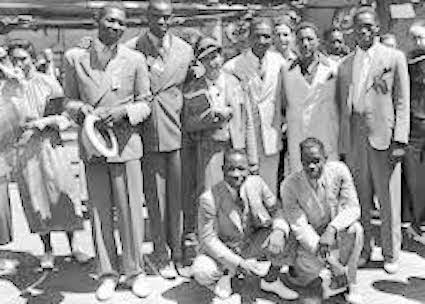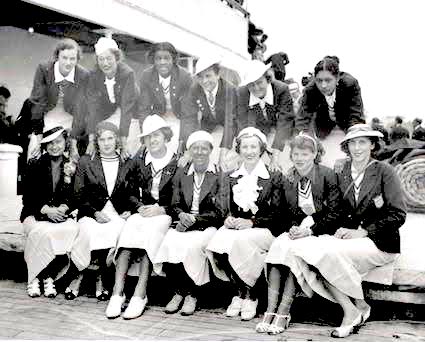History was made just before the 1932 Olympics by Fraser; unfortunately, her race most likely played a role in her not getting an opportunity to compete
(Ed. Note: Following is the second and final Part Two of a two-part series on one of Malden’s most renowned athletes, Louise May Stokes Fraser. Part One appeared in the March 24 edition of The Malden Advocate.)
It has been 91 years since history was made just before the 1932 Olympic Games, when a fledgling young runner put her hometown on the international map. Malden’s own Louise May Stokes, still just a teenager quite new to the world of organized athletics, was thrust into the national spotlight with her selection to the U.S. Olympics women’s track and field contingent.
Stokes, then just 18, and fellow selectee Tidye Pickett of Illinois were groundbreakers and history makers. The two teens were the first-ever Black women to be selected for a U.S. Olympic Team, in this, the VIII Olympiad. It was only the second Olympics in which women were even permitted to compete in track and field events.
It was also only the second time the Olympics were to have been hosted in the United States, this time in Los Angeles, Calif. It would be another 52 years before the Olympics would return again to the United States, in 1984, again in L.A.
Selected for two Olympic Games, never chosen to compete in an event
Sadly, Stokes never got the opportunity to formally compete in an event in the Olympic Games, despite her selection to the women’s contingent not once, but twice. After the 1932 Games, she continued a regimen of training and competition, which earned her another spot on the women’s team for the 1936 Olympics held in Berlin, Germany. For the second time, Stokes was not afforded an opportunity to compete in an event that year.
A number of sports historians and researchers have claimed Stokes was denied the opportunity to compete because of her race. The chief evidence pointed to is that she was replaced at the last minute, both in 1932 and 1936, by white athletes in her event, the 4 X 100 women’s relay. Though both relay teams would go on to win Gold Medals as first-place finishers in each year, setting a new world record in 1932, some researchers insist Stokes and Pickett both deserved to have run in those races.
In 1936, Pickett did achieve some notoriety when she became the first Black woman to compete in the Olympics, in the hurdles event. However, fate was not with her as she broke her foot in the semifinals of her event and was forced to withdraw.
Once again, she joined her Black teammate, Stokes, in the stands to watch the American team win a second Gold Medal in the 4 X 100 relay and tie the world record of 46.9 seconds that the 1932 women’s team had set four years earlier.
Malden rejoiced at Stokes’ great news
When the news hit in 1932, residents of Malden rejoiced at the selection of Stokes to the Olympics team. She was the first-ever Malden resident to achieve such national fame, an achievement that still reigns as unique. To this day she is the only Malden female athlete ever to be so honored. Richard “Dick” Rodenhiser played on two U.S. Hockey Teams in the 1956 and 1960 Winter Olympics – the only other Malden Olympian.
Even as a teenager, Stokes was well-known around the community for her athletic exploits in both track and field and in girls basketball for Malden High School in the early 1930s. Stokes had brought fame to Malden on an international scale a year before her Olympic selection, having set a new world record for women in the standing broad jump event at a Boston-based, regional competition.
In late spring, Stokes joined other Olympic hopefuls, including Pickett, in track trials being held at Northwestern University in Evanston, Ill. For the wide-eyed Stokes, it was the farthest she had ever travelled from her Malden home. What an adventure!
Dominating those trials was none other than someone regarded as one of the greatest female athletes of all time, “Babe” Didrickson, who went on to be a multiple Gold Medalist in the 1932 Olympics and then one of the most successful professional women golfers in history. Stokes and Pickett, the two 18-year-olds, despite their age and experience, did extremely well against national competition.
Pickett hailed from Illinois, so she was not so much out of her element. Not so for Stokes, due to the limited travel of Americans overall in those days. Who knew she would be making even longer and more distant travels that were looming in her immediate future?
Many of the women who competed in the various Olympic trial events had the advantage of formalized training teams sponsored by corporations of the day. For instance, Didrickson, regarded as the best athlete of all those competing, was trained and supported by the nationally known Employee Casualty & Life Co. Stokes had only been training specifically for track and field on a semi-regular basis for just over a year at the time, with Malden track enthusiast Bill Quaine, who had formed the Onteora Track Club in the Malden-North Shore area. Pickett had just a bit more formal training than Stokes.
History made: First two black women as Olympians
Still, both persevered, performed at a high level and prevailed, as each etched their names in the history books as the first Black women to become Olympians. In 1932, Stokes finished fourth in the 100-meter finals with a time of 12.4 seconds while Pickett was right behind her in sixth place at 12.5 seconds.
According to Smithsonian Magazine writer Matt Osgood, in a 2016 article, the method of selection for the four women who would run in the 4 X 100 Relay team for the Olympics women’s team would be the top four finishers in the 100-meter event at the trials, and the fifth (Pickett) and sixth-place finishers would be alternates. The top finishers were Ethel Harrington, Wilhemina “Billie” von Bremen, Elizabeth Wilde, Stokes, Evelyn Pearl Furtsch and Pickett.
Judging from what ultimately transpired, when women’s track coach George Vreeland announced the members of the 4 X 100 team who would compete the next day in Los Angeles, this all changed. It would appear there were two glaring omissions: Stokes and Pickett. Of the top three eventual selectees for the event, only one of the top five Olympic trial finishers was picked – von Bremen, who was to be regarded as the third fastest woman in the world at the time when she won Bronze at the 1932 Olympics at 100 meters.
Harrington, who finished first at the trials, and Wilde, who finished third at the trials, competed only in the 100 meter individual event. They did not compete in the relay and apparently that was decided early.
According to researchers, the women had been told at the Olympic trials at Northwestern that the top six finishers in the 100-meter at the trial would all be in the relay “pool” and the four who would be competing would be selected from the pool. It would appear that Stokes, primarily, and Pickett, most likely, would have a chance to join von Bremen and a fourth runner, Annette Rogers, on the 4 X 100 Relay team.
Rogers was the national Amateur Athletic Union (AAU) 100-meter titlist in 1931 and 1932 and ended up finishing fifth in the 100 meter sprint in the 1932 Olympics. On an interesting local note, Rogers was born in Chelsea, Mass., and lived there in her early years before moving on to become a longtime Chicagoan in Illinois.
It looked like Stokes would break the color barrier
It really looked like an 18-year-old Black woman from Malden was going to break the color barrier in an international event: the first woman of color to compete in a U.S. Olympic track and field competition. But it was not to be for Stokes and Pickett. The quartet for the 4 X 100 Relay was announced, and the roll call did not include either one of them. Instead, joining von Bremen and Rogers on the 4 X 100 Relay Team would be Evelyn Pearl Furtsch of San Diego, Calif., and Mary Carew from – who would have ever guessed it – Medford, Mass.!
Furtsch, also 18 at the time, had a somewhat similar story as Stokes in her early years. Facing little competition from her own gender in her home region, she ran against boys for a couple of years before competing with the Los Angeles Athletic Track Club. She did not have a wealth of national competition experience, though considered a fine, up-and-coming runner.
But she had finished behind three other American sprinters – Wilde, Stokes and Pickett – at the supposedly decisive time trials two weeks earlier.
Her only claim to fame had been a second-place finish in a regional AAU competition. Furtsch was a bit of a local hero; however, as she ran with the highly regarded Los Angeles Track Club at the time, a direct affiliation to that 1932 venue.
The fourth selectee raises even more eyebrows, as Mary Carew had graduated from the school known as Malden High’s fiercest athletic rival – Medford High – just a few months earlier. At age 17, she was seemingly not in the mix in the 100-meter field, individually or in the relay.
Medford woman selected to relay team over Stokes
They called Stokes “The Malden Meteor” during her Olympic run. Carew also garnered a catchy nickname, “The Little Medford Miss.” Like Stokes, Carew had garnered acclaim for her sprinting exploits next door in Medford, but in a shorter distance, the 60-meter sprint. She was a National Champion in the AAU 60-meter dash – four years running! She was tops in the United States each year from 1929-32. Her best time was 7.32 seconds.
Still, a spot on the 4 X 100 Relay Team was Carew’s, much to the dismay of Stokes, Pickett and all of Stokes’ many friends, fellow citizens and supporters back in Malden.
Were she and Pickett denied the privilege of competing for their country because they were Black? Was the color of their skin more of a factor in Coach Vreeland’s decision than the pure ability of these young women?
When asked in later years, Stokes, who added Fraser to her name when she married a local cricket enthusiast, Wilfred Fraser, in 1941, was most often reticent on the matter. “I felt bad but I tried not to show it,” she was quoted in a few biographical pieces, “I just tried to keep it out of my mind.”
Osgood, of the Smithsonian, titled his article, “Sports History Forgot About Tidye Pickett and Louise Stokes, Two Black Olympians Who Never Got Their Shot.”
Pickett was more vocal about the 1932 Olympics decision. According to Osgood, Pickett literally took her bitterness to her grave believing that “prejudice, not slowness” kept her out of that competition, according to her Chicago Tribune obituary.
In another recollection, African-American Olympic History, Pickett is quoted as saying, “They did not allow the better runners to compete,” referring to herself and Stokes. “It was unjust.”
The Chicago Defender, the leading newspaper nationally of what was referred to as “The Black Press,” in the 1920s up until the 1950s, made its opinion of the matter quite clear. “Lily-whiteism,” wrote editor Rus Cowan in The Defender, “a thing more pronounced than anything else around here on the eve of the Olympic Games, threatened and ousted Tidye Pickett and Louise Stokes from participation and put in their stead two girls who did not qualify.”
Of course, at the time in the 1930s, much of America was still very much in the status of segregation, including in hotels, travel by train and bus and in restaurants. This was clearly in place and stated as such in Southern states, and it stretched as far as California at the time.
America of the 1930s had widespread segregation
Recollections of the events leading up to the last-minute omission from the Olympic competition include stories of segregated travel to the Los Angeles venue as well as separate, segregated lodging for Stokes, Pickett and the black men who were competing for the men’s 1932 U.S. Olympic Team. Sadly, all of that was status quo for America at the time, and it appears, judging from a lot of research and some facts that could be construed as evidence, that race ultimately could have caused Stokes and Pickett to be left out in Los Angeles.
Of course, judging that – while Stokes and Pickett were relegated to the stands as spectators – the foursome comprising the 4 X 100 Relay Team raced to a convincing victory, the Gold Medal and a new world record, 46.9 seconds, some could debate that Vreeland chose the right four women anyway, regardless of racial considerations. (In a quirk of the times, the Olympics did not recognize tenths of seconds at that point – believe it or not! – so the record was rounded off to 47.0 seconds for the 4 X 100 relay.) But the facts also point to the extremely high probability that had Stokes and Pickett been placed on the relay team – as the protocols that had been explained to them a few weeks earlier seemed to dictate – then a Malden woman and her friend from Illinois would have made two parts of history. Not only would they have been the first two Black women to compete in the Olympic Games, they would have been the first Black women to have been Gold Medalists as well.
All these women could do was compete as best they could. Through decisions out of their control, they were denied an opportunity to shine, create a once-in-a-lifetime achievement and represent their country on the biggest stage.
As somewhat of a postscript, neither woman was thwarted by this glaring omission. Louise May Stokes was received warmly and with great honor when she arrived back in Malden, as was Pickett in her hometown. Stokes continued to train at a world-class pace and amazingly, she earned another try as a U.S. Olympian at the 1936 Games, this time being held in Berlin. Pickett also had a second try.
These were some of the most well-known Olympics in history, featuring an eventual, four-Gold Medal performance by Jesse Owens, a well-known black athlete, and two Gold Medals by Johnny Weismuller, who gained great fame as the star of the Tarzan movies after the Olympics.
Generous Malden residents helped Stokes get to the 1936 Olympics in Germany
Stokes was beloved in Malden for earning another Olympic Team bid, and Malden residents responded by raising $680 to pay for her transportation to the Olympic Games. To gauge the generosity of locals at the time, that sum is worth $11,172 in today’s dollars! For one round trip ticket! Stokes was humbled and thrilled by the gesture and vowed to do her best.
Unfortunately, “The Malden Meteor,” for the second time in four years, missed out on competing. Once again, she and Pickett were in the 4 X 100 Relay pool, but neither was selected for the competition event.
There were two small bits of consolation. Pinkett did go on to become the first Black woman to compete in the Olympics, in the hurdles event, but she broke her foot in the semifinals and had to bow out. Apparently, she had always trained with loose hurdles, and the ones at the Berlin 1936 Olympic Games were rigid and stationary, which probably played a factor in her injury.
Also, this time around, Stokes finished fifth in the pre-Olympics trials, while Pickett had concentrated on the hurdles. The four participants who were selected for the women’s 4 X 100 Relay Team in 1936 were all highly experienced and previously successful sprinters, unlike the field in 1932. This time around Stokes, again a spectator, saw the women’s team grab a Gold Medal finish and, ironically, tie the still standing world record at 46.9 seconds.
Heroine’s welcome for Stokes in Malden
By all accounts, Stokes got another heroine’s welcome when she came back to Malden after a second Olympics and was honored and revered in her hometown. Stokes fully intended on trying for a third time, at age of 26, to compete in the 1940 Olympics, but the Olympic Games were never played because of the onset of World War II.
As the years went on, she stayed in Malden and around the area, donating her time teaching other young girls and women the sports of track, running and also basketball. She also gained acclaim and was a highly successful professional bowler and was instrumental in helping found the Colored Women’s Bowling Association. She passed away too young at the age of 65 in 1978. The City of Malden named what then was a new fieldhouse in her honor at Roosevelt Park on Salem Street, right next to the old railroad tracks where she used to race the boys in her younger years.
In 1983 she was posthumously recognized and inducted as one of the charter members of the Malden High School Golden Tornado Hall of Fame for her school and Olympics selections. In 1987 a memorial was erected in the courtyard of her hometown high school as part of the extensive renovations completed there. Recently, in May of 2020, Stokes Fraser’s hometown of Malden showed once again that they have never forgotten her and the pride she brought to the city when Mayor Gary Christenson presided over the dedication of a major portion of the Northern Strand Community Trail/“Bike to Sea” path, the Louise Stokes Fraser Loop. Whether she brought home medals or not, the memory, character, passion and legacy of Louise Mae Stokes Fraser will forever shine brightly in Malden history.





